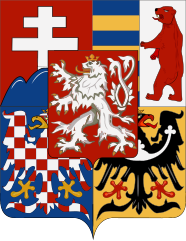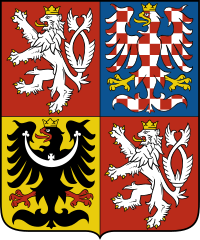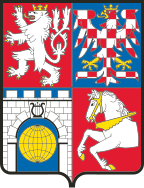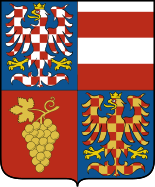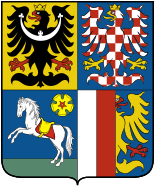Coat of arms of Moravia

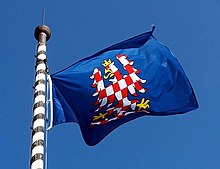

The coat of arms of Moravia has been used for centuries to represent Moravia, a traditional province in the present-day Czech Republic. The coat of arms is also present in a field of the coat of arms of the Czech Republic.
The coat of arms of Moravia is charged with a gold-crowned, white-red-checkered eagle with golden claws, beak, and tongue. The first coat, the seal of the Margraviate of Moravia, is documented only by one worn copy. The gable seal had a design of a lion. The Přemyslid margrave used a seal with a lion in 1239 (as Margrave Vladislav Jindřich had), but the number of tails is unclear; only two are visible on the seal of the margrave (and later king) Ottokar I of Bohemia. The second coat of arms, used from 1233 to 1239, was a typical equestrian one-sided design with the rider bearing an eagle (rather than a lion) on the shield. It is not a Moravian eagle, but a symbol of independence from the Bohemian king in Prague. The seal's equestrian image with an eagle instead of the traditional lion signified the Přemyslid margrave's resistance against Wenceslas I his older brother and king of Bohemia.[2][3][4][5]
In 1758, the citizens of Olomouc were granted the Moravian coat of arms by Maria Theresa in gratitude for their defense against Prussian troops under King Frederick the Great during the Seven Years' War, then with the initials 'F' (for Emperor Francis I), 'M' and 'T' (for Maria Theresa). The coat of arms also appeared on the town seal of Znojmo in 1272, with a 'Z' as its escutcheon. From 1915 to 1918, the Moravian eagle was checkered in red and gold instead of the traditional red and silver.
Moravian eagle
[edit]
In its current form, the Moravian eagle was created by Ottokar II of Bohemia in the mid-13th century after he became the King of Bohemia. The Moravian margrave began to use the silver-red-checkered Moravian Eagle on a blue field in addition to the Bohemian silver lion on a red field.[6][7] Since then, the silver-red-checkered eagle with a gold crown and gold beak, tongue and claws on a blue shield has been used on works of art and official documents.[8][9]
Oldest color representation
[edit]The oldest color representation of the Moravian eagle is in the hall of the town castle (or palace) of Gozzoburg in Krems, Austria; Ottokar II of Bohemia ruled present-day Austria.[10] Since no later than the Luxembourg era, the silver-red checkered eagle was considered the coat of arms of the Moravian region.[11] According to some researchers, these colors derived from the colors of the Bohemian lion (a silver lion on a red shield) and linked Moravia to the king of Bohemia and the Czech monarchy.[12]
Other old color representations
[edit]
Another version of the Moravian coat of arms dates to 1361 in the coats-of-arms gallery of Charles IV at the castle of Lauf, built in 1356 by Emperor Charles IV. near Nuremberg on the Reich Road between Prague and Nuremberg on the ruins of the old Stauf castle. The coats-of-arms hall contains the arms of Moravia and Bohemia, other countries, clergy, nobility, and cities.[13][14]
Origin of the chessboard
[edit]The Moravian eagle differs from other heraldic eagles in its distinctive chessboard design (aquila scacata). The eagle's chessboard is documented on the oldest known seal of Znojmo, from September 1, 1272, the coat of arms of King Ottokar II of Bohemia (who had been the Moravian margrave since 1247). In accordance with convention, the chessboard is formed with lozenges.[15]
Gelnhausen Codex
[edit]The Gelnhausen Codex, written by Jihlava city scribe Jan de Gelnhausen in the early 15th century,[16] contains many illuminated representations of the Moravian eagle and the Bohemian lion.[17]
Oldest written mention
[edit]The oldest written mention of the Moravian eagle is in the versed chronicle of Ottokar Styria, which describes events in Central Europe from the mid-13th century to the end of the first decade of the 14th century. In the description of the battle of Kressenbrunn on July 12, 1260, in which troops of Ottokar II of Bohemia defeated those of the Hungarian King Bela IV, the ekphrasis of the Bohemian banner ("in einem rȏten samît ... ein lewe wîz"; a white lion on a red field) is followed by that of the Moravian banner ("ein geschâchzabelten arn von rȏter und von wîzer varbe"; a white-and-red chequered eagle).[18][19][20]
The charter of Frederick III. Habsburg
[edit]
The charter of Frederick III, Holy Roman Emperor, published by him on the initiative governor of Moravia and marshal of the Kingdom of Bohemia Henri de Lipá on December 7, 1462, changed the Moravian eagle's original silver to gold ("color albus in glaucum sive aureum transmutetur"; white color changed to yellow or gold).[21][22][23][24] The privilege illustrates complex international relations during the reign of King George of Poděbrady. Frederick III issued it to Moravia as a Holy Roman Emperor, interfering with the Bohemian crown's internal affairs; Moravia was ruled by the King of Bohemia.[25]

The change was not confirmed by George of Poděbrady and was never implemented, although the charter met all contemporary legal requirements.[26] In 1628, the charter from 1462 appeared on a list of older privileges formally approved by Ferdinand II.[27] It did not affect the Moravian coat of arms, as evidenced by parliamentary articles published until 1838 and provincial orders of 1545, 1562, 1604, and 1628.[28][29]
The silver-and-red checkered eagle on a blue shield as the coat of arms of the Margraviate of Moravia was confirmed by imperial decrees during the second half of the 18th century and the first half of the 19th.[30] If the change in color (from silver to gold was understood as a change in the emblem, the imperial decrees would have abolished the charter.[26]
The coat of arms described in Frederick's charter was later misused by authors, politicians and political parties at the end of the 18th century and during the 19th; removing the colors corresponding to the Bohemian lion could disrupt state unity. The situation escalated after 1848.[31]
19th century
[edit]
The two versions of the Moravian coat of arms became a problem during the 19th century. The silver-and-red chessboard eagle with a golden crown and armor on a blue shield was centuries old, and the charter of December 7, 1462, allowed its use by provincial authorities. The Moravian provincial administration gradually became aware of the charter during the 1830s and 1840s, which led to increased efforts to have the coat of arms recognized by the emperor. Although he did not recognize it until 1915, some Vienna authorities implied that the use of the red and gold checkered eagle was permitted.[32]
20th century
[edit]Until 1915, the silver-and-red-checkered eagle was used in the large- and medium-sized coats of arms of Austria-Hungary. In October of that year, the chessboard of the Moravian eagle in the medium-sized coat of arms was officially changed from red-and-silver to red-and-gold.
This was the first time a separate coat of arms was created for Austria. Until then, the coat of arms of Austria-Hungary was used for Austria; in Hungary (the Lands of the Crown of Saint Stephen), the Hungarian coat of arms was used.[33][34] The coat of arms was used from 1915 to 1918.
Czechoslovakia
[edit]After the creation of Czechoslovakia, the coat of arms of Moravia (which became part of the country's coat of arms) returned to a silver in chessboard. The mandatory use of silver and red was confirmed by the March 30, 1920 Constitutional Law 252/1920 of the Legal Code of the Czechoslovak Republic.[35][36][37]
Czech Republic
[edit]The coat of arms of Moravia is part of the coat of arms of the Czech Republic, described in the State Symbols Act of the Czech Republic (Act 3/1993 of the legal code). The coat of arms represents the historical regions of Bohemia, Moravia, and Silesia.[38]
-
Coat of arms of Czechoslovakia (1920–1939)
-
Coat of arms of the Czech Republic (1990–1992)
-
Coat of arms of the Czech Republic since 1992, by Jiří Louda
21st century
[edit]After their creation on Jan 1, 2000, each of the fourteen new regions of the Czech Republic obtained the right to ask Parliament to approve their coat of arms and their flag. The Subcommittee for Heraldry and Vexillology of the Chamber of Deputies recommended that the regions take into account their affiliation with their respective historical regions. The Bohemian lion was recommended for Bohemian regions, the Silesian eagle for the Moravian-Silesian region, and the Moravian eagle for Moravian regions and portions of regions. The Moravian eagle used in these coats of arms is a silver-and-red chequered eagle based on the coats of arms of the Kingdom of Bohemia and the Austro-Hungarian monarchy.[39]
The coat of arms of the South Moravian Region has two eagles. The Moravian eagle is in the first field of the quartered shield, and a gold-and-red chessboard eagle with gold armour is in the fourth field.[40][41]
Regional coats of arms
[edit]-
South Moravian Region
See also
[edit]- Flag of Moravia
- Coat of arms of Silesia
- Coat of arms of Czechoslovakia
- Coat of arms of Austria-Hungary
- Czech Wikipedia: Moravská orlice (Moravian eagle)
References
[edit]- ^ "The statue of Jobst of Moravia in Brno was decorated with the Moravian coat of arms, reminiscent of the importance of Moravia". Retrieved 2021-03-31.
- ^ Prinz, Friedrich (1993). Deutsche Geschichte in Osten Europas: Böhmen und Mähren. Berlin: Wolf Jobst Siedler Verlag GmbH. p. 381. ISBN 3-88680-200-0. Retrieved 25 February 2013.
- ^ Maráz, Karel (2014). Sfragistika: studijní texty pro posluchače pomocných věd historických a archivnictví: Panovnická a státní sfragistika. Brno: Masarykova univerzita. pp. 72, 78. ISBN 978-80-210-7143-8.
- ^ "Karel Maráz, Sfragistika: studijní texty pro posluchače pomocných věd historických a archivnictví: Panovnická a státní sfragistika, Brno, 2014, s. 70-95" (PDF). Retrieved 2020-02-13.
- ^ Valecký, Štěpán (2017). Erb českých králů. Zobrazování českého znaku v době Přemyslovců a Lucemburků (in Czech). Praha: Univerzita Karlova v Praze, Katolická teologická fakulta. pp. 30, 37, 39–40, 41.
- ^ Pícha, František (2011). "O klenotu znaku moravského markraběte". Genealogické a heraldické informace 2010 : Moravská genealogická a heraldická společnost, o. s. 2011 (in Czech). Vol. 15. Brno. pp. 7–32.
{{cite book}}: CS1 maint: location missing publisher (link) - ^ Vojtíšek, Václav (1921). Naše státní znaky (staré a nynější) (in Czech). Praha: Vesmír. p. 21.
- ^ Růžek, Vladimír (2013). "Cesty k definici (nejen) moravského znaku a praporu". Veřejná správa (in Czech). pp. 20–22:22. ISSN 1213-6581. Retrieved 2018-12-11.
- ^ Svoboda, Zbyšek; Fojtík, Pavel; Exner, Petr; Martykán, Jaroslav (2013). "Odborné vexilologické stanovisko k moravské vlajce". Vexilologie. Zpravodaj České vexilologické společnosti, o.s. Praha. pp. 3319, 3320.
{{cite book}}: CS1 maint: location missing publisher (link) - ^ Krejčík, Tomáš; Pícha, František (2009). "Český a moravský znak ve znakové galerii v Gozzoburgu v Kremsu". Genealogické a heraldické informace 2008 : Moravská genealogická a heraldická společnost, o. s. 2009 (in Czech). Vol. 13. Brno. pp. 49–57. ISSN 0862-8963.
{{cite book}}: CS1 maint: location missing publisher (link) - ^ Adamová, Karolina (1982). "K heraldické výzdobě Staroměstské mostecké věže. Právně historický pohled". Pražský sborník historický (in Czech). Vol. 15. Praha: Panorama. pp. 44–62. ISSN 0555-0238.
- ^ Růžek, Vladimír (2013). "Cesty k definici (nejen) moravského znaku a praporu". Veřejná správa (in Czech). pp. 20–22:21. ISSN 1213-6581. Retrieved 2018-12-11.
- ^ Růžek, Vladimír (1988). "Česká znaková galerie na hradě Laufu u Norimberka z roku 1361". Sborník archivních prací (in Czech). Vol. 38. pp. 37–311.
- ^ Bobková, Lenka (2004). "Hrady Karla IV. v Laufu a Tangermünde, Panovnická reprezentace vepsaná do kamene". Verba in imaginibus. Františku Šmahelovi k 70. narozeninám, Martin Nodl – Petr Sommer (edd.) (in Czech). Praha.
{{cite book}}: CS1 maint: location missing publisher (link) - ^ Bílý, Jiří (2006). "Moravská orlice, symbol panovníka, země a národa". Moravský historický sborník (in Czech). Brno: Moravský národní kongres. p. 277.
- ^ "Jihlavský archiv ukázal své nejvzácnější dokumenty, jinak nepřístupné". iDNES.cz. 2012-11-03. Retrieved 2019-04-21.
- ^ "Gelnhausenův kodex (kodex A) - právní kniha. Jošt Lucemburský s moravským praporem v Jihlavské právní knize z roku 1407 na foliu 63r". Retrieved 2018-12-11.
- ^ "Ottokars Österreichische Reimchronik (MGH Deutsche Chroniken V,1)". Retrieved 2018-12-11.
- ^ "Ottokar von Steiermark: 'Steirische Reimchronik'". www.handschriftencensus.de. Retrieved 2018-12-11.
- ^ František, Pícha (2013). "Znaky a prapory v kronice Ottokara Štýrského". Vexilologie. Zpravodaj České vexilologické společnosti, o.s. (in Czech and English). Praha. pp. 3320–3323.
{{cite book}}: CS1 maint: location missing publisher (link) - ^ Vojtíšek, Václav (1921). Naše státní znaky (staré a nynější) (in Czech). Praha: Vesmír. p. 22.
- ^ Habrich, Alexius, ed. (1781). "Iura primaeva Moraviae" (in Latin). Brno. pp. 38–42.
- ^ Kalousek, Josef, ed. (1890). "Archiv český čili staré písemné památky české i moravské, svazek X" (in Latin). Praha. pp. 273–274. Archived from the original on 2018-12-14. Retrieved 2020-02-10.
- ^ Bretholz, Berthold (1908). Das mährische Landesarchiv, Seine Geschichte, seine Bestände (in German and Latin). Brno. p. 124.
{{cite book}}: CS1 maint: location missing publisher (link) - ^ Štarha, Ivan. "Historie, moravské barvy a moravská vlajka". Veřejná správa (in Czech). Vol. 2013. pp. 8–9. ISSN 1213-6581. Retrieved 2018-12-11.
- ^ a b Pícha, František (2013). "K 550 letům erbovní listiny císaře Fridricha III. pro moravské stavy". Genealogické a heraldické informace 2012 : Moravská genealogická a heraldická společnost, o. s. 2013 (in Czech). Vol. 17. Brno. pp. 60–80. ISSN 0862-8963.
{{cite book}}: CS1 maint: location missing publisher (link) - ^ Štarha, Ivan. "Historie, moravské barvy a moravská vlajka". Veřejná správa (in Czech). Vol. 2013. pp. 8–9:8. ISSN 1213-6581. Retrieved 2018-12-11.
- ^ Naše znaky státní (staré a nynější), s. 23.
- ^ Sedláček, Pavel (2009). Symboly republiky (PDF) (in Czech). Praha: Vláda České republiky. p. 10.
- ^ Hlinomaz, Milan (1995). "Ke státní a zemské symbolice českého státu v období 1526–1918". Paginae historiae. Sborník Národního archivu (PDF) (in Czech). p. 161. ISSN 1211-9768. Archived from the original (PDF) on 2015-04-02. Retrieved 2018-12-11.
- ^ Mlateček, Karel; Černušák, Tomáš (2018). Morava jako součást českého státu. Společný vývoj od středověku do 20. století. Události – jevy – osobnosti (in Czech). Brno. pp. 130, 132.
{{cite book}}: CS1 maint: location missing publisher (link) - ^ Pícha, František (2018). "Moravské barvy a vlajky v revolučním roce 1848". Genealogické a heraldické informace 2017: Moravská genealogická a heraldická společnost, z. s. 2018 (in Czech). Vol. 22. Brno. pp. 40–41.
{{cite book}}: CS1 maint: location missing publisher (link) - ^ "Vyhláška c. k. ministerského předsedy ze dne 3. listopadu 1915, kterou se stanoví a popisuje znak rakouských zemí". Retrieved 2018-12-11.
- ^ "Kundmachung des k. k. Minister-präsidenten vom 3. November 1915, betreffend die Festsetzung und Beschreibung des Wappens der österreichischen Länder". Retrieved 2018-12-11.
- ^ "Zákon ze dne 30. března 1920, kterým se vydávají ustanovení o státní vlajce, státních znacích a státní pečeti". Retrieved 2018-12-11.
- ^ "Nařízení ze dne 20. srpna 1920 k provedení zákona ze dne 30. března 1920, č. 252 Sb. z. a n., kterým se vydávají ustanovení o státní vlajce, státních znacích a státní pečeti". Retrieved 2018-12-11.
- ^ "Zákon ze dne 21. října 1936 o užívání vlajek, znaků a jiných symbolů, jakož i stejnokrojů a odznaků, a o opatřeních proti závadným označením". Retrieved 2018-12-11.
- ^ "Státní symboly České republiky". Retrieved 2022-03-24.
- ^ Karpíšková, Lucie (2008). "Proces tvorby krajských znaků" (PDF) (in Czech). pp. 24–97. Retrieved 2020-02-10.
- ^ "Interní normativní akt volených orgánů kraje. Směrnice: Znak, vlajka a logo JMK. Zásady pro použití znaku, vlajky a loga Jihomoravského kraje". Retrieved 2020-02-14.
- ^ Karpíšková, Lucie (2008). "Proces tvorby krajských znaků" (PDF) (in Czech). pp. 24–30. Retrieved 2020-02-14.
External links
[edit]- Orlice: Národní orlice: Orlice moravská on Heraldická terminologická konvence (in Czech)

